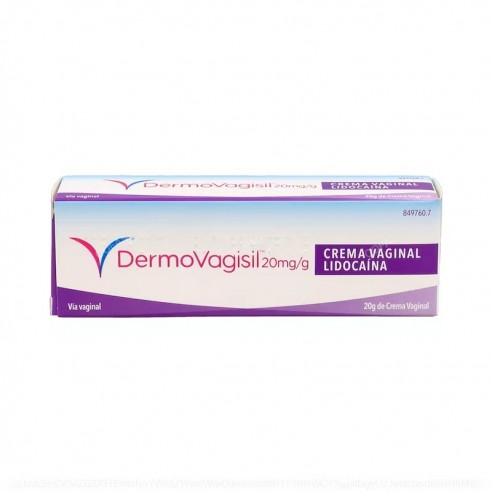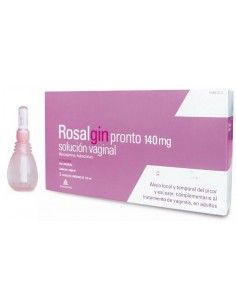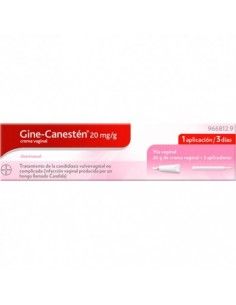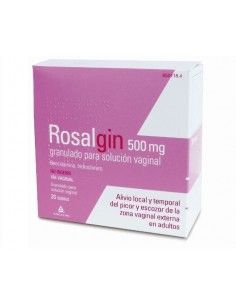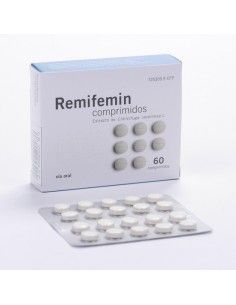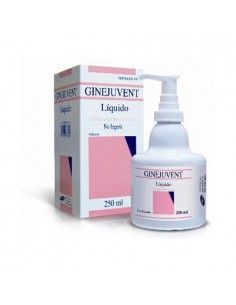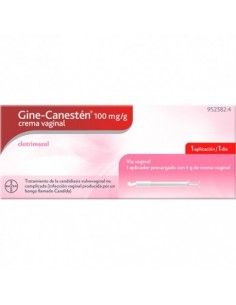Dermovagisil 20 mg vaginal cream 20 grams
Action and mechanism
- Amide-type local anaesthetic. Lidocaine blocks voltage-dependent Na+ channels, decreasing the rate of neuronal depolarisation and the rate of nerve stimulus conduction. The blockade is reversible, and once the concentration falls below a minimal threshold, the nerve fully recovers its nerve function.the blocking effect is not accompanied by alterations in resting potential or repolarisation.the anaesthetic effects appear rapidly, in about 3-5 min, and last for about 1.5 h.
Pharmacokinetics
- Absorption: Systemic bioavailability depends on the amount of lidocaine applied, application time and skin condition. Thus, absorption through intact skin is very low, but may increase when applied to mucous membranes or damaged skin.
- Distribution: moderate binding to plasma proteins (65%), mainly to alpha-1 acid glycoprotein. Vd is 1.5 l/kg. Like other local anaesthetics, it is able to cross the BBB and placenta.
- Metabolism: Intense hepatic metabolism (90-95%) by N-dealkylation reactions, giving rise to monoethylglycinexylidide and glycinexylidide. Both are hydrolysed to 2,6-xylidine, which is hydroxylated to 4-hydroxy-2,6-xylidine. All metabolites are less active than lidocaine. Metabolism is mediated primarily by CYP1A2, and to a lesser extent CYP3A4.
- Excretion: mainly in urine (90%), with 5-10% unchanged and 80% as 4-hydroxy-2,6-xylidine. The t1/2 after i.v. administration is 1.5-2 h, while after topical application it may be up to 12 h, indicating deposition on the skin and slow release into the blood. The Clt is 8-10 ml/min/kg.Pharmacokinetics in special situations:
- Renal insufficiency: t1/2 may increase to 2-3 h, resulting in accumulation of active metabolites. Lidocaine is eliminated by haemodialysis.
- Hepatic impairment: accumulation of lidocaine may occur, as metabolism may be decreased by up to 10% of the metabolism observed in patients with normal hepatic function.
Indications
- VAGINAL PRURITUS. Symptomatic and temporary relief of itching in the external vaginal area, such as that caused by underwear, soap or deodorants.
Posology
It is recommended to use the minimum dose that allows elimination of symptoms to avoid possible systemic effects.
- Adults and adolescents from 12 years of age, topical: apply a thin layer on the affected area, up to 3-4 times a day.
- Children under 12 years of age: safety and efficacy have not been evaluated.Duration of treatment: do not use for more than 7 days. If after 5 days the symptoms do not improve or even worsen, or if redness, pain or swelling appear, consult a doctor and/or pharmacist.Missed dose: do not double the next dose.
Posology in renal insufficiency
- Mild to moderate renal insufficiency (CLcr 30-90 ml/min): no dose adjustment required.
- Severe renal insufficiency (CLcr < 30 ml/min): caution.
Posology in hepatic impairment
- Mild to moderate hepatic impairment (Child-Pugh classes A and B): no dose adjustment required.
- Severe hepatic insufficiency (Child-Pugh class C): caution.
Guidelines for correct administration
- Vaginal cream: Apply the vaginal cream to the affected area with a light massage. Wash hands afterwards.
Contraindications
- Hypersensitivity to lidocaine or [ALLERGY TO AMIDE TYPE LOCAL ANAESTHESIA], between which there may be cross-hypersensitivity reactions.
Precautions
- severe [RENAL INSUFFICIENCY] (CLcr < 30 ml/min). Safety and efficacy have not been evaluated.
- HEPATIC INSUFFICIENCY]. Risk of accumulation due to high hepatic metabolism. Caution in patients with severe hepatic impairment (Child-Pugh class C).
- Cardiotoxicity. Lidocaine has effects on cardiac conductivity and contractility. The efficacy and safety of topical lidocaine in patients with severe cardiovascular disease such as [CARDIAC INSUFFICIENCY], [CARDIAC ARRHYTHMIA], [HYPOVOLEMIC SHOCK] or [CARDIOGENIC SHOCK] has not been evaluated. Close surveillance of these patients is recommended, because of the risk of worsening, and monitoring of cardiac function and ECG. Avoid extensive use.
- Avoid use on mucous membranes, including the eyes, as well as on irritated, inflamed or wounded skin, as this may increase systemic absorption. In case of contact with eyes, immediately flush eyes with lukewarm water or saline and protect them until sensitivity returns, as there is a risk of scratching and corneal irritation.
- METHAEMOGLOBINAEMIA]. Lidocaine may aggravate the symptoms.
Warnings about excipients:
- Because it contains castor oil it may cause allergic skin reactions.
Advice to the patient
- Use the dose recommended by your doctor.
- Do not apply lidocaine to mucous membranes, including the eyes, or to irritated, inflamed or wounded skin. In case of contact with eyes, immediately flush eyes with warm water or saline and protect them until sensation returns.
- Before starting treatment you should tell your doctor if you have had or are suffering from:* severe liver disease* severe heart disease, including cardiac arrhythmias.
- Tell your doctor if you are being treated with:* Antiarrhythmic medicines* Medicines for myocardial infarction, such as nitroglycerin* Nitrofurantoin, an antibiotic for urine infections* Nitroprusside, a medicine for high blood pressure.
- Tell your doctor and/or pharmacist if you have any of these symptoms:* Allergy symptoms such as rash, hives, tightness in the chest, difficulty or noises when breathing, or dizziness.
Special Warnings
- Always use the lowest dose to eliminate symptoms to avoid the risk of systemic effects.
- Monitoring:* Cardiac function, including ECG monitoring, in people with severe cardiovascular disease.
Interactions
No specific interaction studies have been performed with topical lidocaine. It should be noted that in case of significant systemic absorption, the usual interactions with parenterally administered lidocaine may occur.
- Class I and III antiarrhythmics. Risk of potentiation of toxicity.
- Drugs such as nitrates, nitrofurantoin, nitroglycerin, nitroprusside or quinine may increase the risk of methaemoglobinaemia.
Pregnancy
FDA Category B. Safety in animals: Lidocaine had no teratogenic effects in rats or rabbits. At maternotoxic doses in rabbits, increased foetal mortality has been observed. In rats, reduced postnatal survival was reported.Human safety: Lidocaine crosses the placenta. Adequate and well-controlled studies in humans are not available. In general, it is recommended that occasional use during pregnancy may be acceptable, provided that the lowest possible dose is used for the shortest possible time.Fertility effects: No adverse effects have been reported in male or female rats. No human studies have been performed.
Lactation
Lidocaine is excreted in breast milk, but due to its low absorption it is unlikely to affect the infant. Accepted use: The American Academy of Paediatrics and the WHO consider it compatible with breast-feeding.
Children
Safety and efficacy have not been evaluated in girls under 12 years of age and therefore it is recommended to avoid its use.
Elderly
No specific problems have been reported in the elderly that would necessitate a dosage adjustment.
Effects on driving
No particular risks on the ability to drive are estimated.
Adverse reactions
Adverse reactions are described according to each frequency range, being considered very frequent (>10%), frequent (1-10%), infrequent (0.1-1%), rare (0.01-0.1%), very rare (<0.01%) or of unknown frequency (cannot be estimated from available data).
- Dermatological: rare local adverse reactions such as redness or pallor, [CUTANEOUS IRRITATION], [ITCHING] or burning sensation. These reactions are usually due to the anaesthetic effect on blood vessels, and are usually mild and transitory.
- Allergic reactions: rare [CONTACT DERMATITIS]; very rare [HYPERSENSITIVITY REACTIONS], usually involving [URTICARIA], [EDEMA], [BRONCHIAL SPASM], which in severe cases may progress to [ANAPHYLAXIA]; however, in case of significant systemic absorption, systemic symptoms may occur (see Lidocaine, N01BB).
Overdose
Symptoms: Due to the route of administration, intoxication is unlikely to occur. However, severe poisoning has been reported in young children receiving very high topical doses (8.6-17.2 mg/kg). As with any other local anaesthetic, overdose may result in a neurological picture characterised by initial excitation (although this phase may be absent) with nervousness, euphoria, confusion and convulsions, followed by depression with drowsiness, loss of consciousness, respiratory depression and coma. In addition, symptoms such as nausea, tremors, tinnitus, blurred vision, as well as cardiovascular symptoms such as hypotension, cardiac depression and vascular collapse may occur. Treatment:
- Antidote: there is no specific antidote.
- General elimination measures: Lidocaine is haemodialysable.
- Monitoring: monitor patient closely, ensuring respiratory and cardiovascular function, with ECG and blood pressure monitoring.
- Medication:* Convulsions: i.v. diazepam (0.1 mg/kg) or succinylcholine (10-50 mg).* Respiratory depression: administration of oxygen.* Hypotension: vasoconstrictors (preferably with myocardial stimulating activity), administration of parenteral fluids and even blood transfusion.* Methaemoglobinaemia: 1% methylene blue, i.v., at a dose of 1-2 mg/kg for 10 min.

